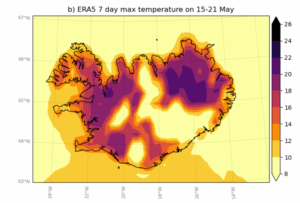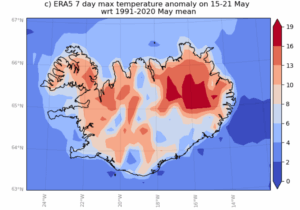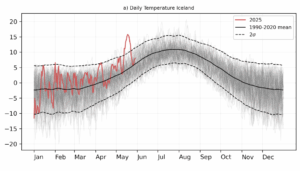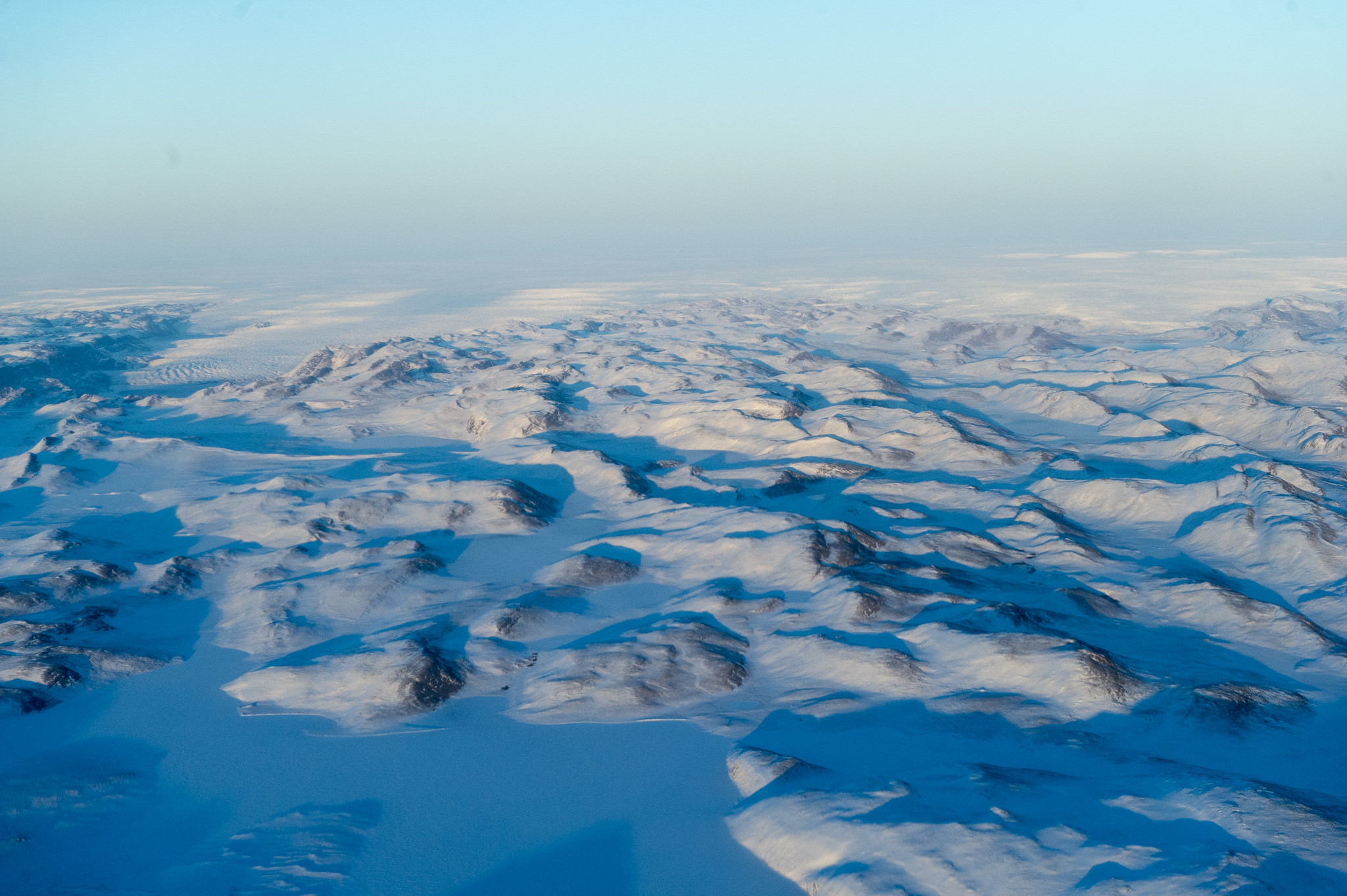On May 15, Egilsstaðir Airport recorded 26.6°C, breaking the previous record for Iceland’s highest May temperature, while regions of the country saw temperatures more than 10°C above average (Icelandic Met Office, 2025). The Ittoqqortoormiit station in Greenland saw temperatures reach 14.3°C on May 19, which is more than 13°C above the May average daily maximum temperature of 0.8°C (DMI, 2025).
These high temperatures were caused by a steady flow of warm air from the south, caused by a high-pressure system near the Faroe Islands and a low-pressure system south of Cape Farewell. This weather setup lasted for about nine days, bringing unusually warm weather to the area. While similar patterns have happened before, this heatwave stood out because it came so early in the year and lasted for so long.
While few impacts have been reported, numerous studies demonstrate that unusually high temperatures early in the year can have significant impacts on local ecosystems. These ecosystems, adapted to very cold climates, are sensitive to temperature shifts, and disruptions to their delicate balance can lead to consequences not only for the ecosystems themselves, but also for the communities that depend on them.
In addition, the heat also directly affects communities adapted to cold climates. Iceland and Greenland differ when it comes to development and access to basic services, and the availability of public infrastructure greatly affects how communities experience heat. In Greenland, especially in rural and remote areas, coping with heat is quite challenging. For example, during the extreme heat and heavy rain in 2022, melting permafrost caused iron and other metals to enter many Arctic lakes, raising concerns about water quality and environmental impacts. Sanitation is also less developed: while urban areas and settlements have piped sewage systems, about 90% of rural homes use bag toilets that are dumped in open areas, increasing health risks—especially in warmer weather when bacteria grow faster.
Researchers from Iceland, the Netherlands, Sweden, Denmark, the United States and the United Kingdom collaborated to assess to what extent human-induced climate change altered the likelihood and intensity of the extreme heat in the region. The analysis focuses on the 7 hottest days in May over Iceland, as the heat was long-lasting there and affected more people, and also on the single most hottest May day at stations Ittoqqortoormiit (Eastern coast of Greenland), Egilsstaðir Airport and Reykjavik (Iceland), to examine exceptional heat on local scales.



Figure 2: TX7x anomaly with respect to May climatology over the period of 1991-2020. Data ERA5.
Main Findings
- A heat wave in a cold-adapted environment can look quite different from other parts of the world. In Greenland and Iceland infrastructure is built for cold weather, meaning during a heatwave ice melt can lead to flooding and damage roads and infrastructure. In Iceland, bituminous bleeding in the roads created dangerous conditions for drivers. In Greenland, unusual warmth causes sea ice to break up, which threatens communities that depend on it for hunting, fishing, and travel. This affects food security, mobility, scientific research, and Indigenous knowledge. Warmer seas are also shifting fish populations—while cod and mackerel are increasing, cold-water species like shrimp and halibut are moving north, causing economic challenges. Additionally, more seaweed growth and less available fodder have forced farmers to import hay from Iceland, increasing costs and creating cross-border dependencies.
- Temperatures over Iceland as observed this May are record-breaking, more than 13°C hotter than the 1991-2020 average May daily maximum temperatures. In today’s climate, which globally has warmed by 1.3°C, the 7-day maximum and temperatures observed in 2025 in the study region have a return time of about once every 100 years. In a 1.3°C colder climate such temperatures would however have been extremely rare.
- When combining the observation-based analysis with climate models, to quantify the role of climate change in this 7-day heat event, we find that climate models underestimate the increase in heat found in observations, but not by as much as in other regions. Based on the combined analysis we conclude that climate change made the extreme heat about 3°C hotter and about 40 times more likely. There is more uncertainty in the estimate for the increase in likelihood and notably it is much smaller than in other heat attribution studies in extratropical latitudes. Given the known underestimation of temperature trends in climate models, this is thus likely an underestimation.
- At a global warming of 2.6°C the likelihood and intensity of such events continue to increase, at least doubling in likelihood and increasing by a further 2°C in intensity.
- The new record of 26.6°C occurred at Egilsstaðir, in East Iceland, and is estimated to have a return period of about 110 years in the current climate. Analysing the Egilsstaðir and Reykjavík stations for Iceland we find slightly lower trends in the magnitude of May maximum 1-day temperatures, compared to the gridded Iceland average 7-day heat. The Ittoqqortoormiit station in East Greenland on the other hand shows a trend in 1-day heat similar to the 7-day Iceland-average heat and extrapolating back to the preindustrial climate indicates that May temperatures have become about 3.9°C hotter since then.
- Both countries reflect the broader Arctic trend for rising temperatures and associated changes in precipitation and hydrology that are beginning to make climate adaptation more pressing. Currently Iceland is in the process of formalising climate change adaptation plans, with necessary improvements to infrastructure and affected societal systems, while Greenland is in the early stages of responding to heat as an emerging public health threat.





